How to properly trim thuja?

For gardeners who are engaged in the cultivation of ornamental crops, it is often necessary to prune them. This procedure is divided into sanitary and decorative. Cultivating thuja, the owner of a coniferous plant will need to carry out both activities, so it is important to know how to do it correctly.

Why prune a tree?
Novice gardeners often have a question about the advisability of pruning coniferous crops. However, in the process of growing various varieties of thuja, it will become clear that without a formative "haircut", not every tree or dwarf shrub will be able to maximally demonstrate its decorative appeal.
Second, but an equally important goal of pruning thuja is the annual sanitary molding of the crown of the tree, which is necessary to remove unattractive dead woodwhich will negatively affect the appearance of the culture. In addition, sanitary pruning will allow the plant to update regularly and in a timely manner, avoiding the development of certain diseases, including fungal infections.
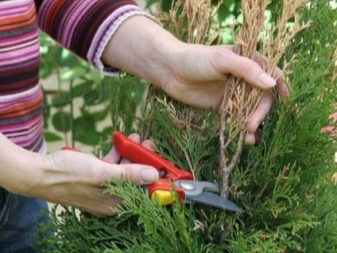

The right time
It is worth noting that any planted tree will need pruning immediately, such a gardener's work will allow you to immediately set a growth vector for the plant, which will greatly facilitate the task of care and cutting in the future.
In general, the choice of a suitable time frame for such work will directly depend on their goals. Thuja can be cut not only in the spring, but also in the autumn months. Sanitary pruning is recommended to be carried out with the arrival of warm spring days, when the movement of sap in plants has just begun; at the end of the summer season, before wintering, dry branches and underdeveloped shoots are also subject to removal.
Formative care will need to be started after the planned spring pruning and carried out before the arrival of autumn. The frequency of the activities carried out will be individual, taking into account the age of the plant, the time of planting and the variety. As a rule, in one season, the gardener will carry out 1-2 formative pruning of an adult thuja, as well as several corrective work with the crown.
As for the "cosmetic haircut", these events are not tied to specific dates, so their frequency will depend on the growth of branches on the tree, which will clearly stand out in size from the total mass.
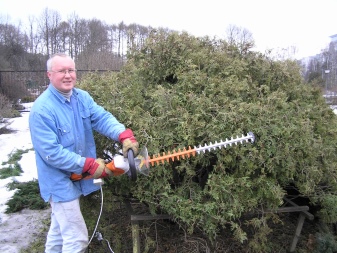
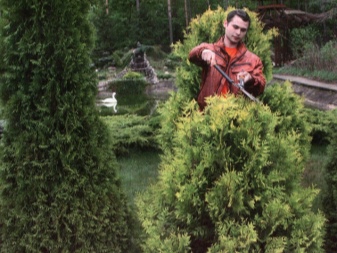
Required tools
In the process of growing conifers and bushes, the gardener will need a certain set of tools that will speed up and facilitate the work of giving the plant the necessary shape. So, the following inventory may come in handy in the garden:
- secateurs;
- gardening scissors;
- sickle;
- gloves.
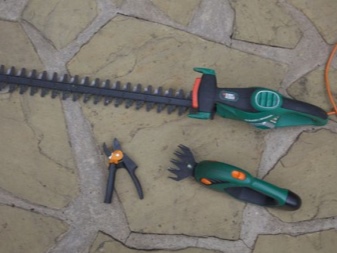

The first tool is necessary to shorten the length of the branches of the plant, and it will be more convenient to cut the thuja with scissors, carrying out the decorative molding of the crown. It is best to cut off large shoots with a sickle. Professional garden tools can be not only mechanical, but also electrical. However, in small areas, when caring for young trees, the presence of ordinary mechanical tools is sufficient.
Thuja is able to secrete resin, which is problematic when dried out from the skin. That is why it is recommended to carry out garden work with it with gloves.

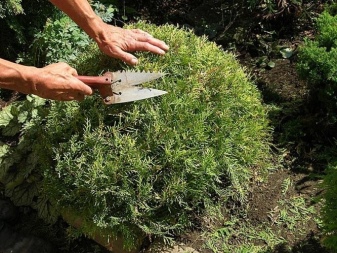
Fundamental rules
It will be quite difficult to form a beautiful crown without practical experience. Therefore, experienced gardeners recommend that beginners adhere to some rules of working with the culture.
- Any curly or decorative haircut will require a preliminary study of the original outlines of the thuja, from which it will be easier to build on in the future. It will be difficult to give an interesting shape to the top if the height or width of the perennial is less than intended.
- In order to form an attractive thuja in your country house, initially, in order to avoid severe stress from the plant, only 1/3 of the branches must be removed. Usually, in the fall, the shoots that have grown over the summer are removed, due to which the future form of culture will be gradually set.
- In order to beautifully trim a spherical perennial, you should avoid the presence of shoots on the plant that are devoid of greenery. This is due to the peculiarities of the needles, which do not have “dormant” buds on their branches.
- In order to properly shorten the length of the branches, as well as give them the correct direction of growth, you first need to choose the tool that is ideal for the job. It is better to have several types of garden shears, differing in size, in order to use comfortable ones during work. Beginners should be aware that garden tools, like any other, need to be sharpened and disinfected from time to time. Sharp blades will not make problematic breaks and dents in wood.
- It is best to postpone pruning for a cloudy day. Such a nuance will eliminate the formation of brown or yellow spots on the needles.
After the work is completed, the plants must be well watered. Also, experienced gardeners recommend additionally introducing root fertilizers to adapt the plant.
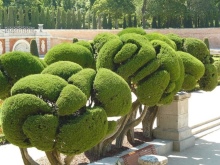

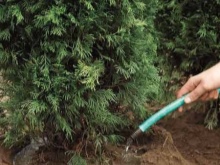
When starting curly trimming, you must take into account the following rules.
- First of all, it is recommended to outline the areas on the perennial that will be removed.
- The tips are shortened by no more than 20 centimeters. If more is cut, then the crop may not stop the main growth. In this case, the shoots will begin to lengthen no earlier than a couple of months.
Crown formation
There are several of the most common options. perennial crown formation:
- pyramidal haircut;
- columnar;
- spherical.
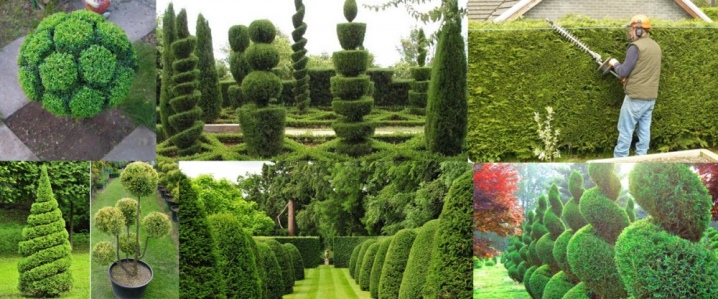
Among the large number of varieties of coniferous culture, there are varieties that are perfectly suited for creating a pyramid from the crown, since the culture initially grows upward in the form of a cone. To make it easier to form the selected shape, the trimming process is carried out step by step with the creation of a special frame from small slats, corresponding in number to the edges of the pyramid. Shoot pruning is done everywhere in all areas, if you cut it off, dividing into zones, then you will not be able to get the correct cone.
The columnar haircut option is in demand in landscaping areas that will have a small area. Thuja cut in this way, with proper care, form a dense hedge if several plants are planted in one row. Such a row should be formed at the very beginning, as soon as coniferous perennials appear on the site. To create a green hedge, all trees are pruned to the same height, removing no more than one third of the plants. The following works are being carried out in the next season.
Such manipulations with the crown will allow you to set the direction of growth of the branches, as well as stimulate the development of lateral shoots, which will make the hedge denser.
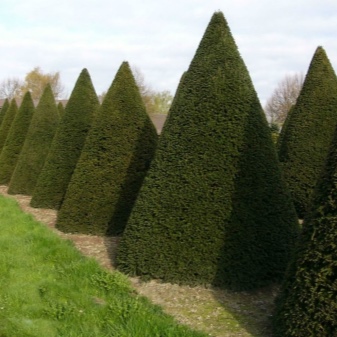
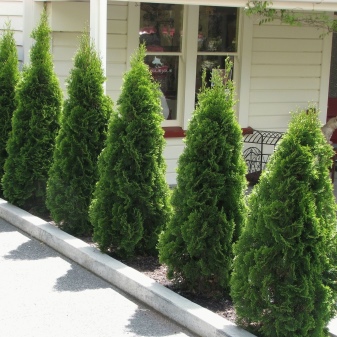
Columnar haircut of thuja can include crown shaping when the tops are narrower than the bases. To achieve uniform plant heights, gardeners are advised to use a measuring stick when pruning along it. In this case, it will be more convenient to work with a pruner. Shaping will need not only the tops, but also the sides of green spaces, they are usually corrected with mechanical garden shears.
A ball of thuja can be made if you limit the growth of branches vertically by shortening the crown. This technique will be the impetus for the development of a plant in width. Further, the gardener will need to remove long shoots that are knocked out of the general shape, gradually forming a crown with rounded outlines.
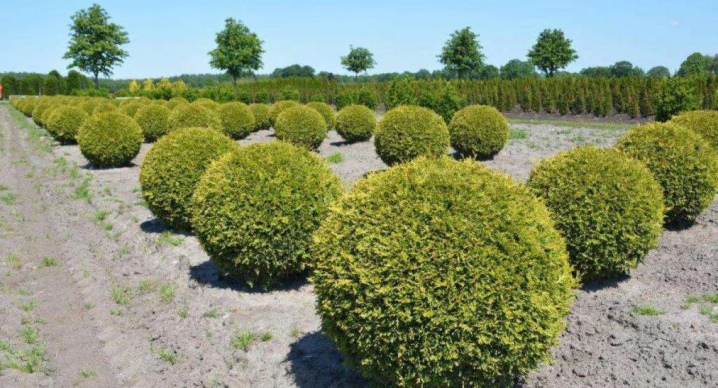
Decorative haircut ideas
More experienced gardeners, in addition to the most common options for pruning perennials, resort to creating extraordinary, but no less spectacular forms from the crowns of coniferous crops. Among the most interesting ideas are the following.
Topiary haircut
The essence of working with plants is to implement the most intricate shapes. Such manipulations with trees have been carried out for quite some time, however, the list of shapes and figures is regularly supplemented with new species and master classes. Today, the forms of conifers are popular, repeating the contours of animals, birds, and marine life. Moreover, such ideas, most often, are striking in their size. A perennial can act as an independent figure or as part of a whole composition in landscape design.
Topiary pruning stands out for the peculiarity of the work, when the gardener will use a variety of supporting and forming frameworks for the plant. Thanks to such an additional device, a specialist will be able to make evergreen sculptures of various sizes from thuja.
The coniferous perennial is quite pliable and plastic, so the bends of the figures can be very diverse.
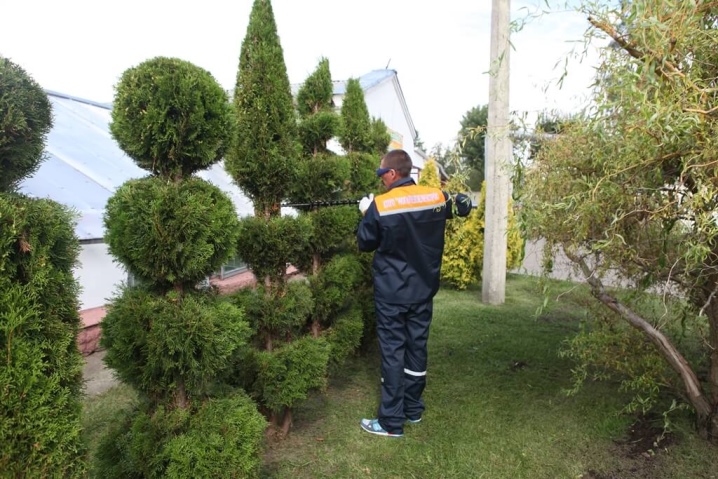
Spiral pruning
Today, such a design of thuja is especially in demand among designers involved in landscaping private and public areas. A similar practice of working with needles is actively adopted by ordinary gardeners. The main requirement for a plant when creating a spiral is that the culture has an even trunk. If the tree has several of them, then the bases are simply fastened together.
Shaping the shape will require preliminary marking on the tree. For these purposes, a rope or tape is used, which will set the line of movement of the spiral. Some gardeners use spray paint for marking.
Initially, the haircut should not be deep, clearer and deeper turns of the culture are set gradually, with the help of a planned corrective haircut. Usually, a thuja haircut of such a plan is carried out only with scissors.

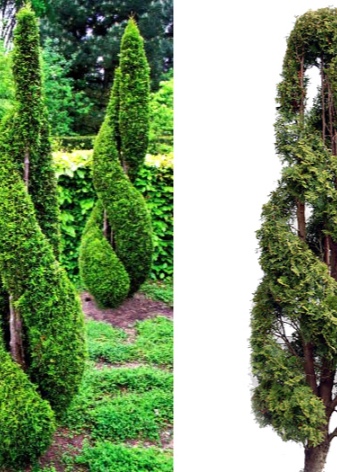
Ovate crown formation
Designers note the simplicity and, at the same time, high decorative attractiveness of a plant trimmed using this technique. It is easiest to create this figure from perennial varieties that initially have a spherical or ovoid crown. In this case, the gardener's task will only be to correct the appearance of the plant, without complex markings, installing frames and other preparatory measures.
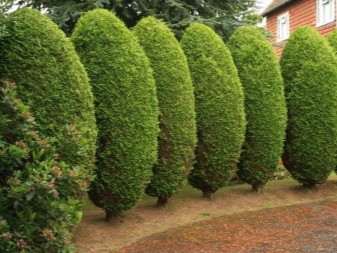
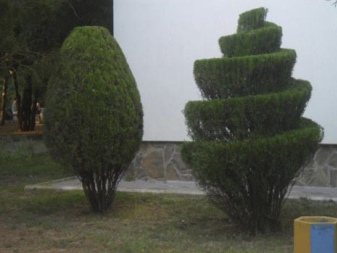
Haircut "paws"
This option involves working in the bonsai technique. The main task in this case will be to trim the side shoots so that small "legs" remain at the ends of the branches. Formative pruning work is carried out with branches bent downwards, which are usually fixed with ropes or a small weight.
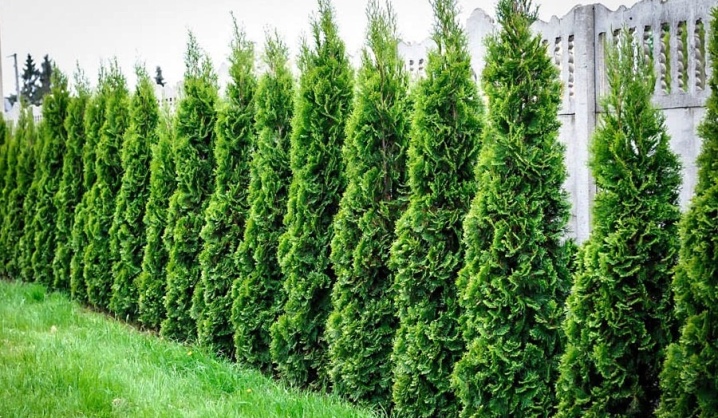
Thuja horizontal haircut
The essence of the work is to trim low crops. In this version, a fishing line is stretched on top, which will act as an obstacle to the growth of shoots upward. It is pulled in the spring, with the arrival of autumn, the shape of the crown is adjusted by removing the vertically stretched branches. In order for the culture to grow horizontally, a variety of weighting materials are also used.that attach themselves to shoots, preventing them from reaching for the sky.
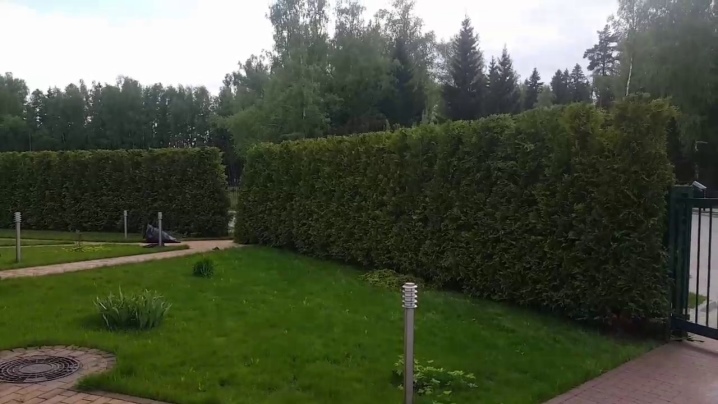
For cropping thuja, see the next video.



































































The comment was sent successfully.